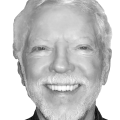News & Articles
Browse all content by date.
Psst! Hey, buddy, ya wanna have cheaper gas. Slip me a twennie an’ I’ll give you all ya needa know.
First of all, drive the speed limit. I’ve checked my speedometer and know that it is accurate at 30, a bit over at 50, and 71 at 70. Most modern cars have relatively accurate speedometers compared to a couple of decades ago. Whenever you go faster than the speed limit, you use more gas than you would at the limit. I bet that almost every driver of those cars that go over the limit complain about the price of gas.
Second, coast to stop lights and stop signs. I am amazed how many drivers pass me with a red light ahead. I coast up to the light and we are both waiting.
Third, take the bus. The more people take a bus, the fewer cars on the road using gas. The fewer cars using gas, the less the demand. The less the demand, the lower the price of gas.
Yeah! I know! I wimp out on taking the bus. What with the un-shoveled walks and the effort to not miss the bus, I drive to certain places more often than I take the bus. But, we can encourage other people to take the bus.
First, we can keep our sidewalks clear so that others can easily walk to the bus stop. I know, it’s a pain to move all the snow the plows dump on our walk. Even after the city sidewalk snow blower comes by, there is an inch or two of packed snow. We can do our best to clear down to the pavement; that will certainly provide more stability for pedestrians.
Second, we can be willing to pay more taxes to encourage bus ridership. One is to pay for snow removal rather than snow plowing. With snow removal rather than plowing there is less snow to be pushed onto the sidewalk after the next storm. Two is to provide more funds for the transit authority to run buses more often.
What, pay more taxes for buses? “No way, I don’t take the bus; why should I pay for others to take the bus?” If you pay others to take the bus, then there is more room on the road for you. It’s not so bad here in Duluth with its “rush minute”, but think of the Twin Cities with its rush day.
People don’t seem to understand that a whole bunch of things happen as more freeways are built. First, the more freeways, the more drivers. Maybe there is relief for a year or two, but then… Second, the more freeways that are built, the more taxable land that is taken off the tax rolls. Third, as that taxable land is used up in the city, there is less housing in the city. Fourth, as there is less housing, people seek housing farther out. Fifth, as people seek housing farther out, they need to drive more. Six, as more people drive… Oh, I forgot to mention as there is less taxable land to pay for streets, then there needs to be a higher gas tax to pay for the freeways.
In the late 60’s I spent several weeks now and then on business in Basel, Switzerland. My job required me to spend many evenings at Sandoz headquarters a couple miles from the hotel in the center of town. I often took the tram both ways. Even returning to the hotel at midnight, I never waited more than ten minutes for the tram.
I looked up the current schedule at http://www.blt.ch/service/fahrplan/haltestellenfahrplan.html and asked for Voltaplatz to Aesch (the end of the line to the East). Monday to Friday the tram starts at 4:43 every 15-29 minutes and 5:42 every 7-8 minutes until 8:17 in the evening when it runs every 15 minutes until 1:12 the next morning. Oops, don’t miss the last tram. It is ten minutes after the next to last tram.
It is hard to have an excuse for missing church on Sunday because the first tram is at 4:44, second at 5:32, and then better and better. From every 15 minutes to every 10 minutes back to every 15 minutes, the last tram is 32 minutes after midnight.
The service isn’t cheap. A simple fare runs from $1.80 to $3.70. You can buy the tickets at “ticketautomaten” and several other places. It’s a bit different than when I paid a conductor directly something like 25-50 cents. He would ask “Bis?” meaning “to where” and then tell you how much.
There is also extensive bus service, but I don’t remember ever using it. I either walked, took the nr. 11 tram, or rode in someone else’s car.
Basel has about twice the population of Duluth. It is long and narrow like Duluth but it is relatively flat. The biggest hill I remember walking up wasn’t much bigger than Woodland between E. 8th St and Mt. Royal. Also, Basel is probably more dense with apartment buildings rather than single-family houses.
I can’t say what auto traffic is now, but Basel has several expressways and tunnels that weren’t there in the late ‘60s. I know many people were upset about these. But throughout Europe, people are rethinking trams. That is a story for another day.
You can find more of my thoughts at
http://magree.blogspot.com
| Tweet |


